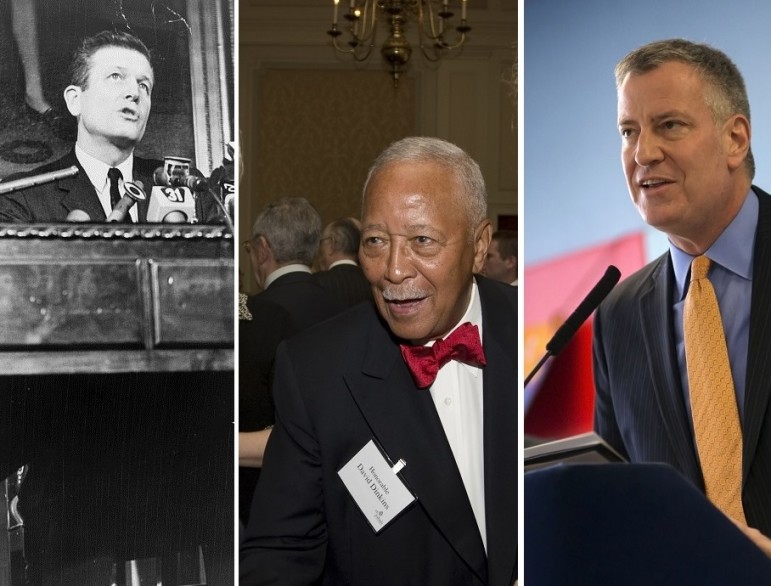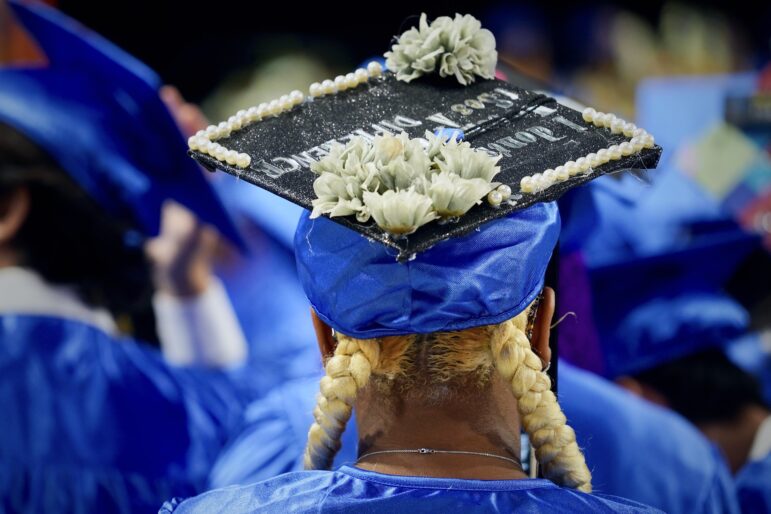
Library of Congress, Rubenstein, Ed Reed/Mayoral Photography Office
Mayors Lindsay and Dinkins endured tough fights over expanding civilian review of the police; Mayor de Blasio is in a fight to defend the man now overseeing that review system.
Here’s a bright-line rule: Don’t compare people to animals. Someone turns state’s evidence, we call them a “rat.” Ugh. Virginia Senator George Allen tried to be funny, compared an Indian-American man to a monkey, and is now a former Virginia senator. And now the head of the New York City board that reviews alleged police abuses has referred to police union offi-cials as “pigs.” Boo, hiss.
“I was chosen by Bill de Blasio because of my extensive knowledge of police cases,” Civilian Complaint Review Board (CCRB) chairman Richard Emery told the Daily News. “I’m not going to deprive the public and people who are abused by police officers of having access to excellent lawyers because some union is squealing like a stuck pig.” The quote was in reference to questions about whether it’s a conflict for Emery to head the CCRB while part of a law firm representing a man suing the city for alleged police misconduct that the CCRB investigated.
It’s worth noting that one of those union officials offended by Emery’s quip, Patrolmen’s Benevolent Association president Patrick Lynch, is the man who suggested Mayor de Blasio had blood on his hands for the December 2014 police killings, and therefore no stranger to the use of indelicate, nay, wildly inappropriate language. But Emery’s porcine reference is still unfortunate.
Even more worth noting, however, is that the recent dust-up over Emery’s potential conflict is the latest salvo in a 50-year battle over civilian review of the New York police department.
While the first efforts to create a method for citizens to complain about their treatment by cops date to the 1950s, it was John Lindsay who after his 1965 election first tried to introduce civilians to the review process. This was met by fierce opposition from the PBA, with the union’s president John Cassese, saying “I’m sick and tired of giving in to minority groups with their whims and their gripes and shouting.” It didn’t end there. According to author Sean Deveney:
…[T]he PBA began running an ad in newspapers and on billboards, showing a young white woman looking frightened as she considers entering a subway station on a dark street, with the headline: “The civilian review board must be stopped! Her life … your life … may depend on it!” …. “The only thing it didn’t show was a gang of Negroes about to attack her,” Lindsay said. “It was a vulgar, obscene advertisement if there ever was one.”
Vulgar, but effective: Voters approved the PBA-backed referendum dismantling the Lindsay board by a two-to-one margin. There still was a review board, but it was composed only of police officers.
In the 1980s, Congressional attention to police misconduct in New York opened the door again for a civilian presence on the review board. A 1987 city law expanded the board to 12 members, with six appointed by the police commissioner and six by the mayor. “At this time, the Civilian Complaint Investigations Bureau began to hire civilians to investigate complaints,” the CCRB notes in its own history, “though these civilians served alongside police department investigators and were supervised by department employees.”
The 1988 Tompkins Square Park episode, where video footage showed officers brutalizing demonstrators, triggered a wave of calls for a civilian review board. Mayor David Dinkins supported that reform, leading to protracted debate with the City Council and the infamous September 1992 police riot at City Hall. Ultimately, the Council passed a compromise: The new CCRB would be independent of the police and have 13 members: five civilians appointed by the mayor, five civilians appointed by the Council and three law-enforcement officials appointed by the police commissioner.
The board today retains that structure, although its history since ’93 has never been quiet. During the Bloomberg administration, the Board was undermined by then-Commissioner Ray Kelly’s penchant for ignoring CCRB disciplinary recommendations, although ultimately CCRB won wider powers to prosecute officers it accused of misconduct. Under de Blasio, even before the brouhaha over Emery’s legal connections, the PBA had complained about CCRB’s reluctance to punish people who lie about alleged police misconduct, rejected Emery’s call for more videotaping of police actions and labeled the board “nothing more than cop-hating branch of the New York Civil Liberties Union.”
In the first half of 2015, the CCRB investigated 4,611 allegations of misconduct. Officers were exonerated in 20 percent and allegations were deemed unfounded in 8 percent. In some 13 percent of allegations, the officer could not be identified. And in nearly half—46 percent—of allegations, no finding on the merits could be made. The CCRB substantiated misconduct in 12 percent of allegations. Imagine the kind of animal metaphors that would get thrown around if the CCRB found wrongdoing at a rate greater than one in eight.








